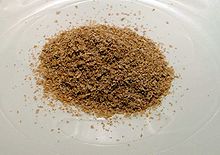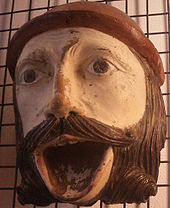bran
Bran ( ahd. Kli (w) a ) is a collective term for the residues from the husks (seed husk, fruit husk), the aleurone layer and the seedling that remain after grain processing after sieving the flour . Bran is a mill by-product and not to be confused with the husks .
In the past, bran was mainly used as animal feed . In the context of wholefood nutrition , bran has become increasingly important as a source of fiber for human nutrition (for example in muesli , graham bread or in crispbread ). Bran consists mainly of the non-starch carbohydrates cellulose and hemicellulose, as well as lignin .
Milling extraction
Since bran essentially consists of the outer layers of the grain, the grain must be thoroughly cleaned of adhering dirt, microorganisms and any other contaminants before grinding. This is done in the flour mill by means of black and white cleaning .
Bran is the residue of outer layers and seedlings that remains after grinding and sieving the flour ( plansifter ). As a mill byproduct , bran should contain a maximum of 20% starch. The composition of the bran depends on the milling technology used. In the case of wholemeal flours or meal, the bran is also ground.
composition
Average composition
The bran of selected types of grain has the following composition:
| Ingredient (%) | wheat | rye | oats | rice | barley |
|---|---|---|---|---|---|
| Non-starch carbohydrates | 45-50 | 50-70 | 16-34 | 18-23 | 70-80 |
| Strength | 13-18 | 12-15 | 18-45 | 18-30 | 8-11 |
| protein | 15-18 | 8-9 | 13-20 | 15-18 | 11-15 |
| fat | 4-5 | 4-5 | 6-11 | 18-23 | 1-2 |
Average composition of wheat bran
The composition of wheat bran naturally fluctuates, both depending on the environmental conditions (soil, climate) and the cultivation technique (fertilization, plant protection).
Details per 100 g of edible portion:
|
|
|
|
* Protein content according to the EU directive on nutrition labeling; (Factor: 6.25): 16.0 g
** Difference calculation
1 mg = 1000 µg
The physiological calorific value of wheat bran is approx. 720 kJ / 100 g (172 kcal / 100 g), for oat bran it is approx. 1,312 kJ / 100 g (309 kcal / 100 g).
Health importance
The swellable and mucus-forming components of bran (β- D - glucan and water-soluble xylans ) ensure that the increase in blood sugar after starch intake is delayed, which is desirable for people with diabetes . In addition to vitamins and minerals, the outer layers of the grain also contain undesirable ingredients such as antibodies against predators (such as phytin ) and impurities (such as pesticides , heavy metals and mold toxins ). Phytin binds minerals and vitamins in the intestine and thus prevents these substances from being used for nutrition.
When using bran for human nutrition, care must be taken to ensure adequate hydration, otherwise serious constipation can result. In the worst case, it can lead to a life-threatening intestinal obstruction .
Bran was and is valued as a feed component especially for horses because of its high fat, protein and magnesium content. However, the protein cannot be used well. Bran also contains a lot of phosphorus, so that the phosphorus / calcium ratio is unfavorable. This used to lead to miller's horse disease and can be avoided by adding lime. Bran is included in some mash recipes and is used as additional feeding when it is soaked (max. 10%).
See also
literature
- Wilfried Seibel (Hrsg.): Goods knowledge of grain . AgriMedia, Bergen / Dumme 2005, ISBN 3-86037-257-2 .
- Peter Erling (Hrsg.): Manual flour and peeling mill . AgriMedia, Bergen / Dumme 2004, ISBN 3-86037-230-0 .
Individual evidence
- ↑ a b Waldemar Ternes , Alfred Täufel, Lieselotte Tunger, Martin Zobel (eds.): Food lexicon . 4th, comprehensively revised edition. Behr, Hamburg 2005, ISBN 3-89947-165-2 .
- ↑ German Research Institute for Food Chemistry (DFA), Garching (Hrsg.): Food table for practice . The little souci · specialist · herb. 4th edition. Wissenschaftliche Verlagsgesellschaft, Stuttgart 2009, ISBN 978-3-8047-2541-6 , p. 244 .
- ↑ Helmut Sigel: Zinc and Its Role in Biology and Nutrition. Dekker, New York 1983, ISBN 0-8247-7462-0 ( Metal Ions in Biological Systems. Volume 15), p. 333.
- ↑ https://www.pferdchen.org/Pferde/Ernaehrung/Pferdefutter/Weizenkleie.html , accessed on Jan. 13, 2018.
- ↑ http://www.pavo-futter.de/beratung/f%C3%BCtterung-und-zucht/pferdefutter-und-rohstoffe-welches-pferdefutter-fuer-ihr-pferd , accessed on January 13, 2018.
- ↑ https://www.dr-susanne-weyrauch.de/gesundheit/futtermittel/weizenkleie , accessed on Jan. 13, 2018.

